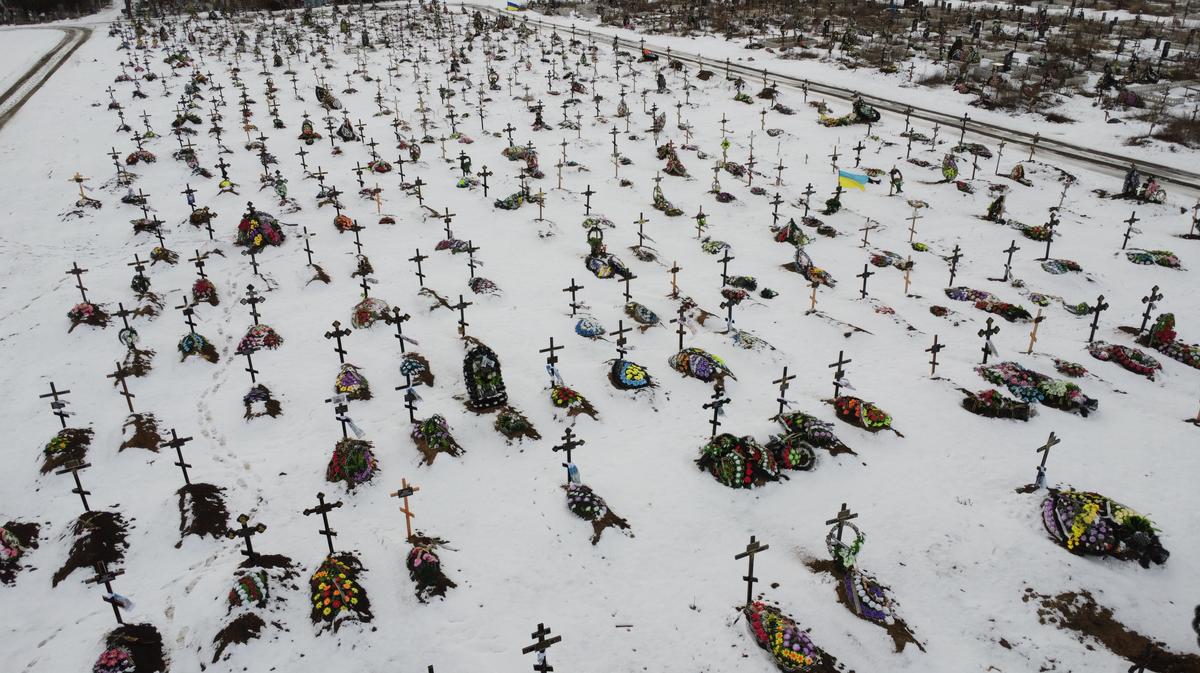Today, on the first day of the second year of the war, Novaya Gazeta Europe publishes a report by the Human Rights Centre Memorial in which the latest events are compared to the events that occurred during other Russian wars — the Syria War, the First and Second Chechen Wars.
All of this did not start just a year ago. The annexation of Crimea took place ten years ago, then the aggression in Ukraine’s east a short time later. And further on, up until the beginning of a new democratic Russia. In general, our country has been at war almost non-stop for over forty years, since Afghanistan. It all comes from there — “purges”, “filtration”, or using Grad missiles on populated cities. We were trying to find an answer to the question: how are these practices shared and repeated?
“The goal of wars, of crimes, of impunity” — the last word is key here. Impunity for past crimes leads to new crimes. A demand for justice — as in, punishment for those guilty of war crimes and crimes against humanity — is not just a figure of speech. It is, probably, the only way to break this chain.
Alexander Cherkasov
Introduction
Russia’s massive invasion of Ukraine, launched on February 24, 2022[1] , is an act of aggression unparalleled in European history since World War II[2]. This war is criminal and terrible, and the widespread response to it is understandable.
However, this war was preceded by other armed conflicts with open Russian participation, albeit smaller in scale, but comparable in methods used. It is also important that at times these armed conflicts involved the same actors, the same military units and formations, and the same officers and generals. In a whole series of previous post-Soviet armed conflicts involving Russia, the First and Second Chechen Wars as well as the armed conflict in Syria stand out.
We have tried to see and present the events of Russia’s aggression in Ukraine from the perspective of other major wars that the Russian Federation has fought in the three decades of its existence. This perspective is, of course, very incomplete. The selection of events and episodes in each section may seem random or incorrect. Anyone who follows events in Ukraine can say that they are given here in isolated strokes. The authors may be rightly reproached for describing the First and Second Chechen wars in more detail than all of the subsequent events. But that is precisely the nature of perspective: what is far away gets overwritten in the memory by new events and is forgotten. By reconstructing the scale of events, we refine our assessment of them. By changing the perspective, by returning to the events of the 1990s, to the first Chechen war waged from 1994 to 1996, we can see how bloody, brutal and despicable that war was. This approach seems to allow us to understand that the chain of contemporary mistakes and crimes extends further, and that the problems that generated them run deeper.
The post-Soviet wars waged since the early 1990s have not been a chain of random events and coincidences. They should be seen as a chain of wars, a chain of crimes, a chain of impunity. Impunity for past crimes generates new crimes and provokes new criminals. Surovikin, Strelkov, and other “heroes” of the war in Ukraine brought with them the experience of three decades of unpunished violence. The butchered city of Mariupol is a consequence of the destruction of Grozny. The impunity for the murderers of Samashki and Novye Aldy inevitably spawned Bucha. The “filtration camps”, through which Mariupol residents had to pass, inherited the “filtration system” that had existed in Chechnya. There can be no lasting peace without memory and justice.
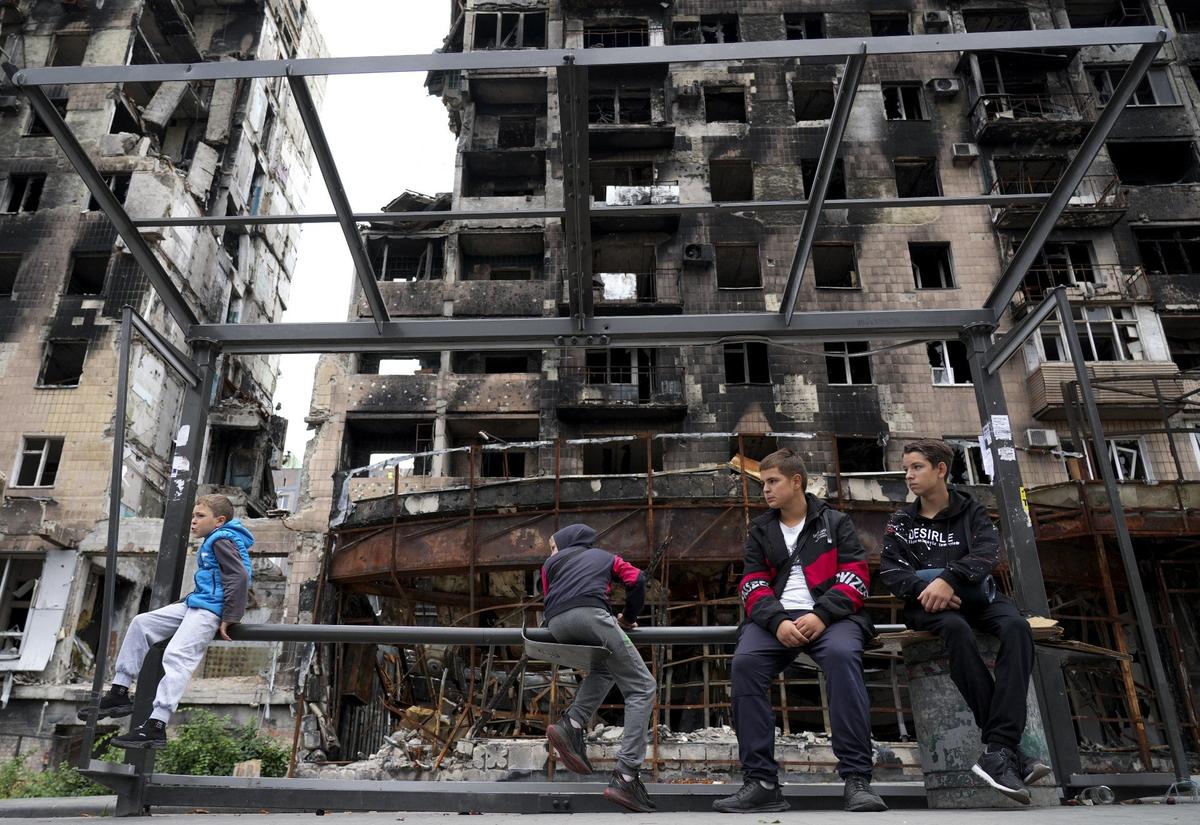
Children waiting at a destroyed bus stop in front of damaged buildings in Mariupol. Photo: Stringer / Anadolu Agency / Getty Images
In order to show, firstly, the reproduction of these criminal practices in various armed conflicts and, secondly, the mechanisms of this reproduction, we have prepared a brief report rubricating the various violations of international humanitarian law and illustrated with examples from those wars. This summary report was more than a hundred pages long; the present brief is an attempt to summarize it within ten pages. Clearly, any attempt at an even, proportional shortening of the original text would have been doomed to failure, since it would have resulted in a loss of both logic of reasoning and accuracy. Therefore, this reduction is obviously uneven. Our brief, while preserving the structure of that report, contains, in a somewhat condensed form, its main statements, but the factual material that illustrates them is normally given in the form of brief references to the relevant episodes, decisions of the European Court of Human Rights, etc. The reader interested in any of our assertions, conclusions, and, in particular, statements or their confirmation, may refer to the relevant section of the “big” report.
* * *
After the collapse of the USSR in December 1991, the new democratic Russia seemingly disengaged itself from post-Soviet armed conflicts. Russia officially acted as a “peacekeeper” in the armed conflicts in Transnistria (June 1992) and South Ossetia (July 1992). However, a closer look reveals that in the “peaceful” 1992, Russia was in fact involved in five “hybrid wars” at once[3].
Those conflicts had been gradually “frozen” by the mid-1990s, but at that time the First Chechen War had already started. Eventually, having suffered a military defeat and brokered a ceasefire in August 1996, Russia withdrew its troops from the rebellious republic by early 1997.
The loss of life amounted to 30,000 to 50,000 citizens of the republic, and up to 6,000 Russian “security personnel”, making Grozny the most destroyed city in Europe.
In August 1999, the Second Chechen war started; it took the lives of 15 to 25 thousand Chechens whole 3 to 5 thousand Chechens “disappeared”; the losses of security services amounted to 6 thousand. As a result, the totalitarian regime of Ramzan Kadyrov, who managed to become “indispensable” to the Kremlin, was established in Chechnya.
In the mid-2000s, some of the conflicts seemingly resolved in the 1990s were “unfrozen”. As a result of the 2008 war in Georgia after Russia’s recognition of the independence of the rebel autonomies, up to 20% of Georgian territory were occupied. In that war, Russia, for the first time, openly stepped beyond its borders.
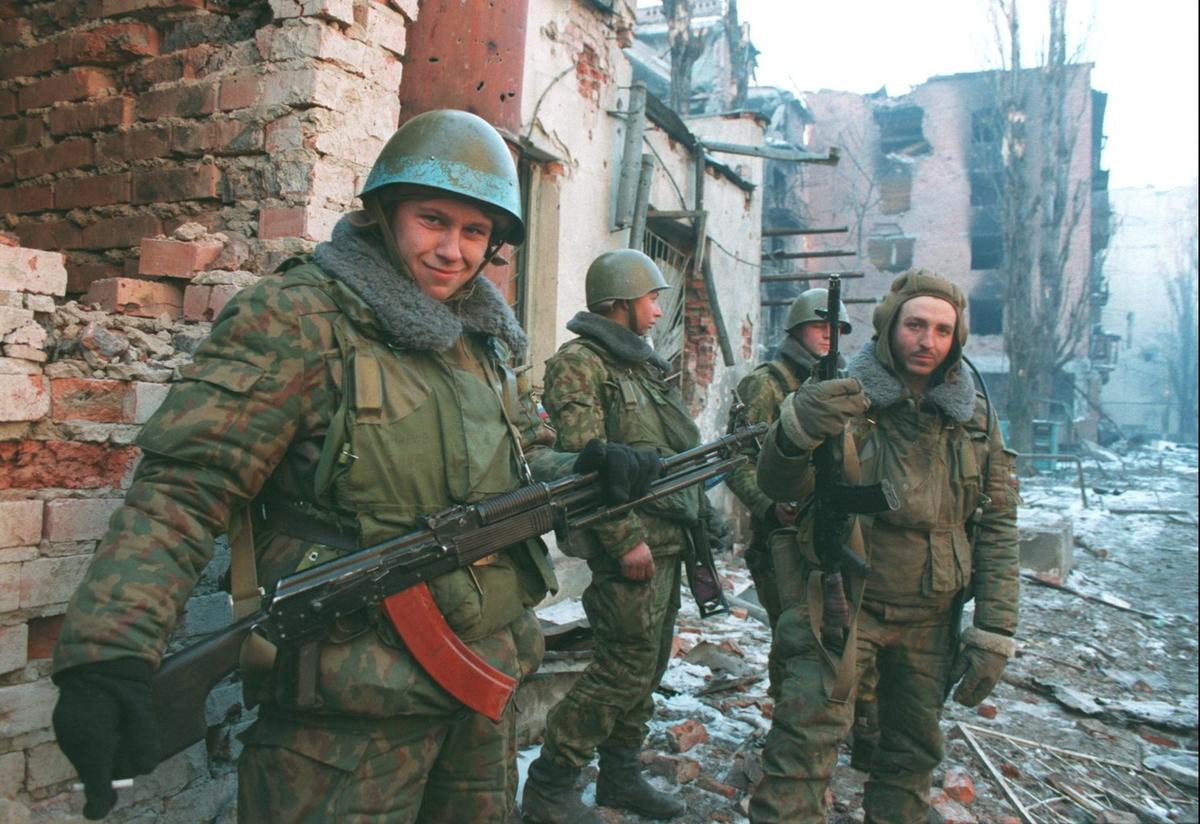
Russian soldiers patrolling the ruins of Grozny, 1995. Photo: Georges DeKeerle / Sygma / Getty Images
In February 2014, Russia occupied and then annexed Crimea, after which it launched a “hybrid war” in eastern Ukraine — in the Donetsk and Luhansk regions. Apparently, the plans were broader than that. Destabilization was triggered throughout the south and southeast of the country, from Kharkov to Odessa. An army group was ready to conduct a large-scale offensive operation which was not launched at the time.
In September 2015, Russia openly joined the armed conflict in Syria on the side of Bashar al-Assad’s regime. The conflict there had began in 2011, on the wave of the Arab Spring protest movement. The government’s brutal suppression of the secular democratic movement naturally led to its gradual radicalization and eventually contributed to the emergence of ISIS which controlled significant territories, used blatantly terrorist methods, and sought to create a “caliphate”. From the outset, Russia supported its longtime ally Assad despite the crimes committed by the government forces and the enormous (by European standards) civilian casualties caused by the civil war unleashed by the government. One of the goals expressed by the Russian representatives was to wipe out fighters from the North Caucasus who had come to the ISIS-controlled area. Another goal openly stated by the Russian leadership was to test weapons systems and combat readiness of all branches of the armed forces. In fact, in Syria, the army was preparing for new wars, and most of the officer corps (specifically, all commanders of Russian troops in Ukraine had at different times held the post of Commander of the corps in Syria) and military pilots had gone through this war.
Here, Russian “private military campaigns”, primarily Wagner, got a free hand and earned a grim reputation.
One of the results of the Syrian campaign was (deservedly or not) the reputation of the Russian army as “the second in the world”.
This is how the Russian Federation approached the year 2022, i.e. the start of a large-scale invasion of Ukraine. Looking back, we see the events of the last 35 years, the armed conflicts in Russia, in the former Soviet Union and then beyond not as a series of separate, unconnected episodes, not as a sequence of random coincidences — but as logically connected events. The crimes committed in each of the conflicts have not been investigated. The perpetrators were not named, condemned and punished, and so they participated in new wars, reproducing and disseminating their experiences. It was a chain of wars, a chain of crimes, and a chain of impunity.
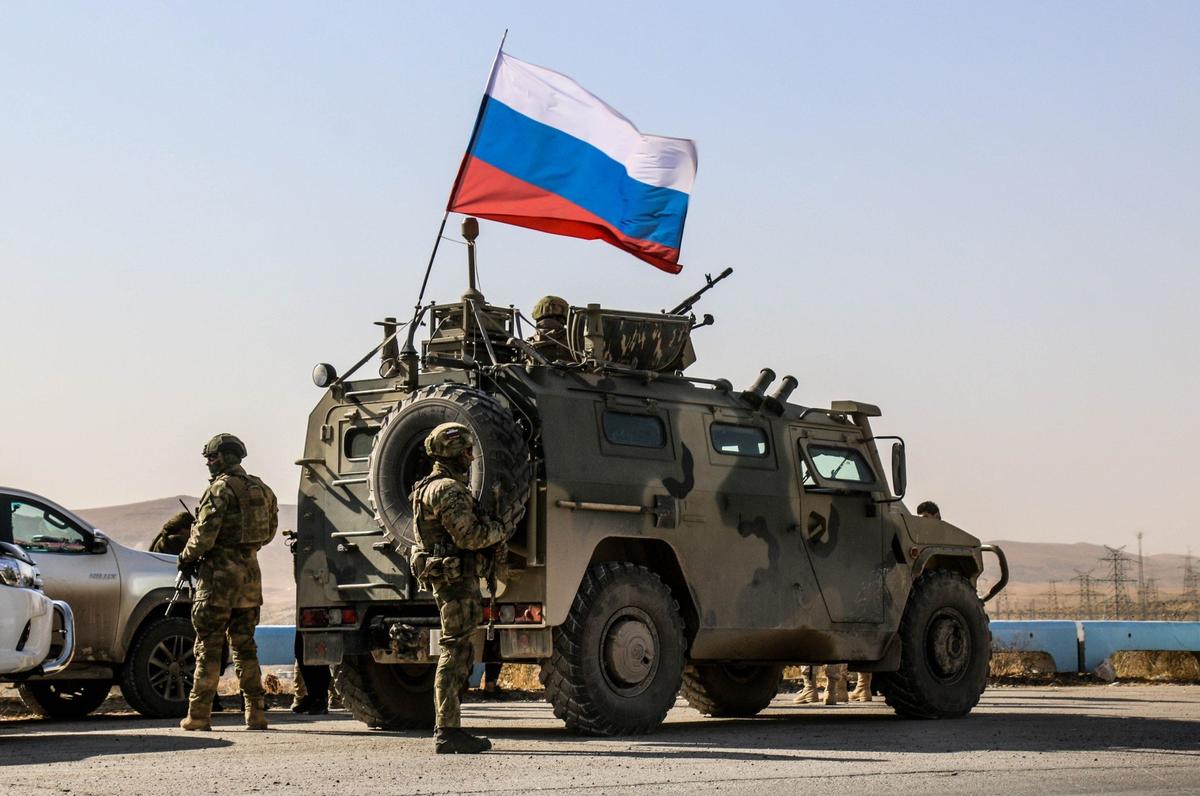
Russian soldiers, with Russian flag, are seen on armoured vehicle as they enter the base at the Tishrin Dam. Photo: Bekir Kasim / Anadolu Agency / Getty Images
* * *
We do not claim, nor do we wish to prove, that the Russian Federation is the only state that has violated human rights, humanitarian law or other international treaties and conventions during armed conflicts. There has not been and there is not a single conflict in which both sides have not violated the laws and customs of war. The question here is, firstly, the scale of such violations and their prevalence; secondly, their accidental or systematic nature; and thirdly, the way they are treated by the command, judicial system, and state authorities. Do these institutions try to reduce their degree and number? Or, on the contrary, do they encourage them? What real steps are being taken to achieve this? Have the military and police committed crimes against civilians with the full knowledge of their commanders, or in defiance of their orders and instructions? Are the military and political leadership of the belligerent side prepared to punish those responsible for serious violations? Are the authorities investigating crimes against civilians committed by “their” military and police agencies? Do they investigate only violations of military discipline, or also those committed under orders? Are investigators limited to the perpetrators themselves, or does the investigation look into the chain of command? Is there a systemic pattern to the actions of a warring party that knowingly result in the death and suffering of civilians? And if we see such a systemic nature, is it possible to trace the continuity of violations in different conflicts in which this side has been involved at different times?
The answers to these questions determine the assessment of the actions of each of the parties.
Our report is an attempt to put these questions about our country to our country itself — and to find the answers.
1. Factors Affecting the Ability of the Russian Armed Forces and law enforcement agencies to Respect Human Rights and Humanitarian Law
The following account of the actions of the Russian armed forces and other security services in armed conflicts, since 1994, speaks not only of stable, reproducible patterns of behavior of individual commanders who determined the way their units and formations have acted. Gross and mass violations of human rights and humanitarian law, which were not total but widespread and systematic, were reproduced at a higher level. And this is by no means a trend of recent decades — it has deep roots, from the time of the Soviet Union.
Russia, in fact, has remained (with only minor interruptions) a country at war not only since 1991, but also longer, since the Afghan war, for more than forty-three years.
This chain of wars has led to the emergence and reproduction of a subculture in all kinds of security forces, special services and special forces.
The Second Chechen War, which began in 1999, was a springboard for Vladimir Putin, who turned from a little-known bureaucrat into an electoral leader and then made the “counter-terrorist operation” almost the main method of running the country. Under the pretext of the fight against terrorism, the parliamentary and party systems (regardless of how they worked) and relatively free mass media were systematically dismantled, fundamental rights and freedoms were curtailed, and civil society was consistently attacked.
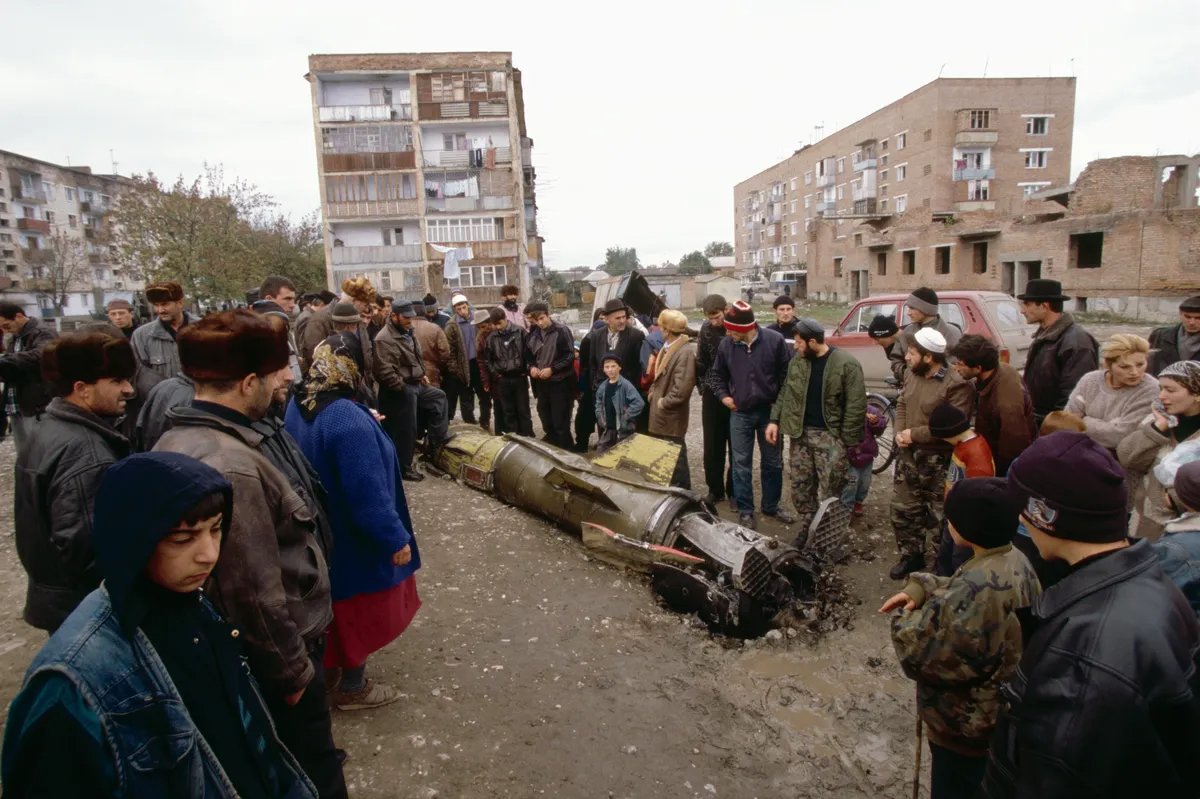
Missile sent by the Russian army to the suburbs of Grozny. Photo: Antoine GYORI / Sygma / Getty Images
By the beginning of the 2000s, the opposition “rights and freedoms” vs “security and stability” had taken root in Russia, although in fact no long-term security and no stability are possible without respect for human rights and freedoms. In the “naughts”, Russia had oil and gas, which, with high hydrocarbon prices, provided resources for financing the expanding law enforcement agencies. This also “formatted” society: people in Russia were increasingly oriented toward the civil service.
“Historical politics” played an important role in this transformation of Russia. For Putin’s regime, which was looking into the past, history almost became the main “battlefield”. The result was a sacralization of power itself, the cult of the special services and of everything “special” and “unusual” — that is, outside the law. In this world picture, the law could be circumvented if it got in the way, and laws did not have to be constitutional.
Until very recently, while starting wars, the Russian state did not declare a state of emergency or martial law, and the war was not called a war or an “armed conflict”. In 1994 in Chechnya it was “disarmament of bandit groups” and “imposing constitutional order”; in 1999 it was an “anti-terrorist operation”. In 2008, in Georgia, it was an “operation to enforce peace”. Now Russia is conducting a “special military operation” in Ukraine.
Another path to this war, associated with “historical politics”, was the state’s transformation of World War II-related memory. The result was the replacement in the mass consciousness of the slogan “never again” with “we can do it again!”
*****
The experience and legacy of the Soviet army gave little reason to hope that post-Soviet armies would make respect for human rights and humanitarian law their primary goal. The Great Patriotic War was a “total war”. Many practices going back to that time proved resilient and were visible in the post-Soviet wars. These include the treatment of human casualties as an unavoidable cost, both in the troops and among the civilian populations — as well as the massive use of aviation and, above all, artillery, including in urban warfare and the takeover of settlements. They are also the treatment of the population in the liberated European countries and the impunity of this violence. They also mean the repression in the army itself, first of all, for the lack of automatism in following orders, for discussing the real situation and for political disloyalty, and, lastly, for violations of laws and customs of war. They also mean mass repression in controlled territories, treachery, killing of prisoners (subsequently denied), establishment of controlled political regimes, brutal suppression of insurgent movements, and mass deportation of peoples. None of these past events and practices have been worked through, discussed and condemned, which is why propagandists in recent years have often referred to them as positive and worthy of repetition in order to justify new wars.
The post-war Soviet Union and the Soviet Army were preparing for a global confrontation with the “West”, i.e., for a war in Europe, which was also conceived as “total” and implied the use of nuclear weapons as well as conventional weapons of indiscriminate effect or high power[4].
The 1979-1989 war in Afghanistan displayed many qualities of that army: from brutal and criminal practices, massive bombing of settlements with long-range aircraft and Grad strikes, “cleansing” of villages and “filtering” the city population, the system of detention facilities with torture and extrajudicial executions — to clear signs of decay, “hazing” and disregard for the soldiers’ lives.
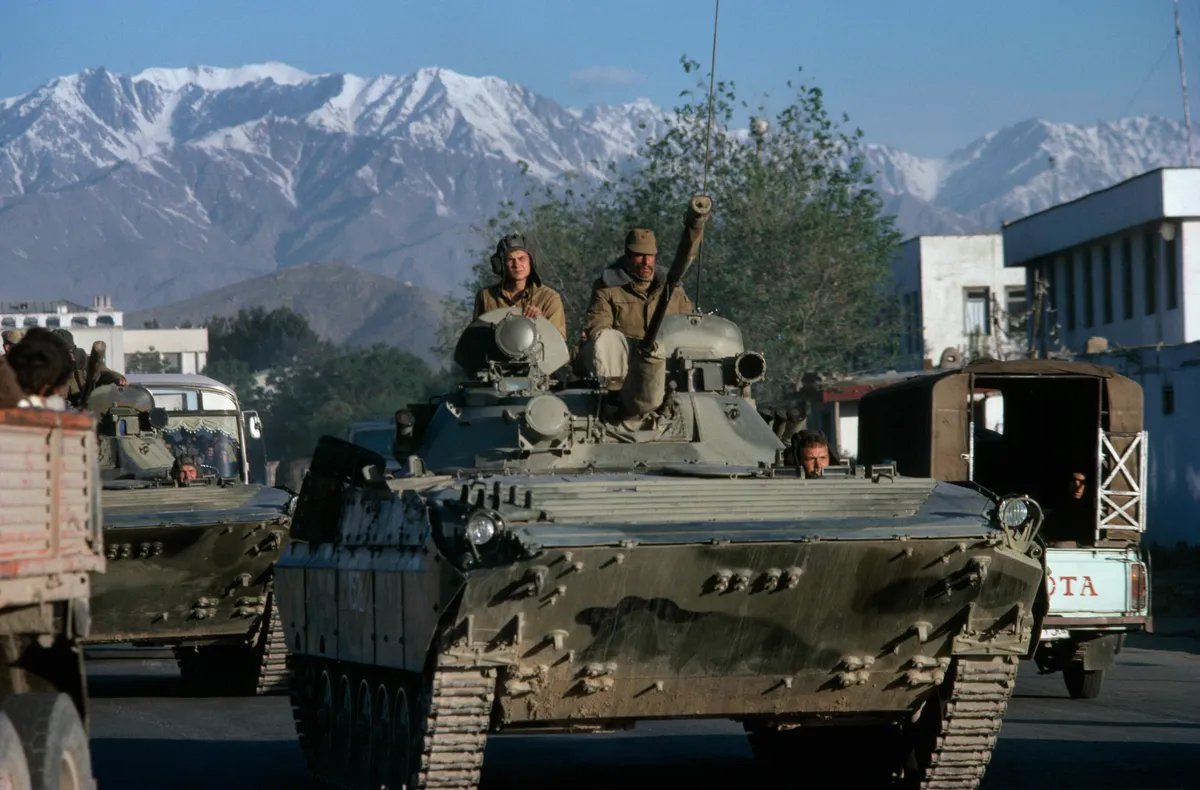
View of Soviet army soldiers in a armored vehicle during a patrol, Kabul, Afghanistan, 1988. Photo: Robert Nickelsberg / Getty Images
Finally, in addition to circumstances that were not conducive to federal forces’ compliance with humanitarian law, there were prerequisites for deliberate violations of those norms, i.e., outright criminal practices.
As for the internal affairs agencies, their activities throughout Russia were accompanied by beatings, torture, extortion, and robbery. When these agencies received special powers, such practices became particularly widespread and cynical. This was also the case during the First Chechen War and in subsequent armed conflicts in which Russia was involved.
2. Violations of Humanitarian law and human rights violations during hostilities
2.1 Indiscriminate attacks, excessive use of force
2.1.1. Indiscriminate bombing and rocket attacks, indiscriminate shelling of populated areas
First Chechen War. During the First Chechen War of 1994-1996, civilians in the Chechen Republic suffered from indiscriminate fire by federal troops and indiscriminate bombing throughout the armed conflict[5]. The way federal troops acted towards civilians and civilian targets varied from place to place and from time to time. This was determined by many factors, among which compliance with the laws of war and the protection of civilians were not decisive factors. Populated areas were subjected to indiscriminate shelling and bombing. As a rule, the population was unable to leave the combat zone through safe corridors. The federal troops, upon discovering (and often simply assuming) that Chechen armed groups had deployed their positions and military facilities in populated areas, began strikes without regard for possible civilian casualties[6].
Second Chechen War. From the very beginning of military operations in Chechnya in the autumn of 1999, Russian officials and the mass media (mainly based on statements by officials) stressed the differences from the first Chechen campaign of 1994-1996: the selectivity of the federal troops and their use of precision weapons to destroy the terrorists with minimal casualties among the civilian population.
In fact, in the first months of the second Chechen campaign, federal troops resorted to massive and indiscriminate bombing and artillery fire during large-scale military clashes. Dozens and hundreds of civilians were often sacrificed to eliminate a few fighters. Just as in the First Chechen War, federal forces used weapons not known to have been designed for selective, pointed strikes[7].
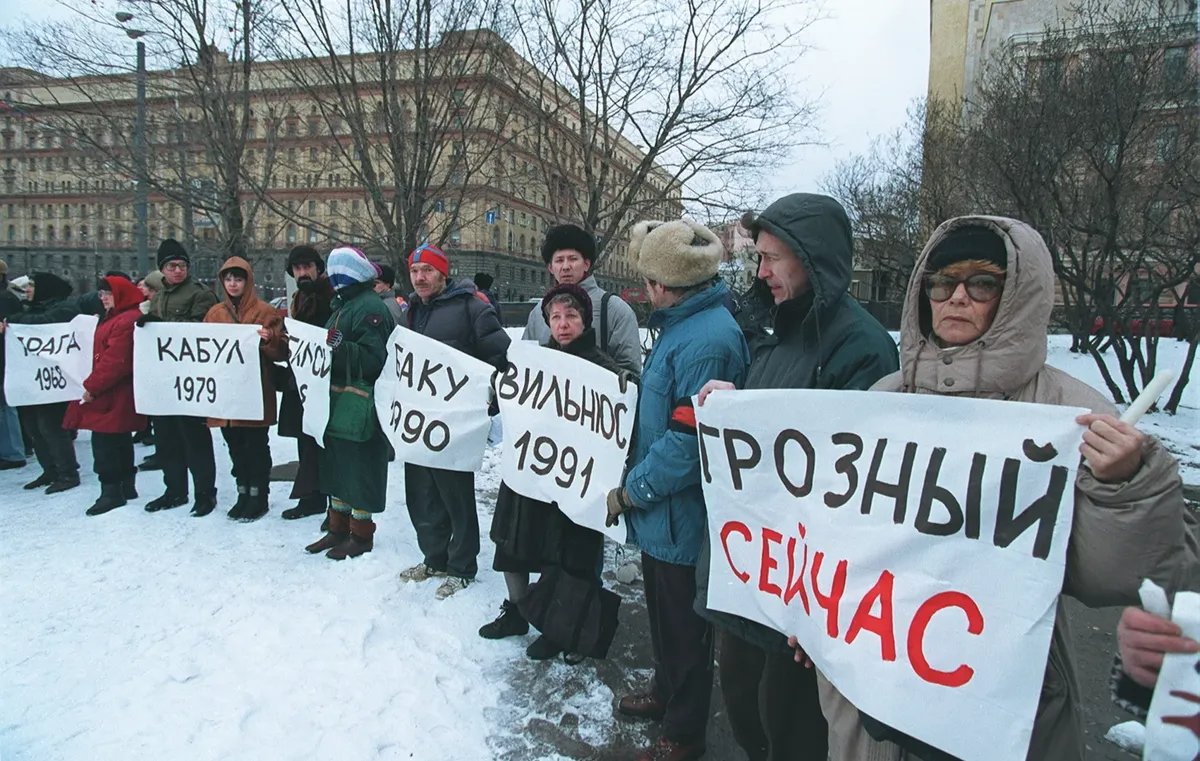
Demonstration against Russian intervention in Chechnya, 1995. Photo: Georges DeKeerle / Sygma / Getty Images
Air strikes and artillery shelling of populated areas throughout Chechnya continued until the end of 1999 and into the first months of 2000. In none of these cases were any of the responsible servicemen held criminally responsible or punished[8].
Battles between the federal troops and Chechen units caused enormous casualties among the civilian population.
Both sides acted as if they were in the desert, disregarding the need to protect civilians: detachments of fighters entered villages crowded with civilians and refugees, while federal forces bombed and shelled these settlements.
Federal forces struck populated areas indiscriminately in subsequent years as well[9].
The operation of Russian forces in Syria. In the course of the war in Syria, both government and Russian forces carried out massive and systematic indiscriminate rocket, artillery and bomb strikes on populated areas. Such strikes were recorded in the provinces of Homs, Idlib, Aleppo, Daraa and others where the Russian Air Force actively participated[10]. Critical civilian infrastructure to support life was destroyed. The Airwars research project estimates that Russian strikes killed between 4,300 and 6,400 civilians and wounded between 6,500 and 10,200.
War in Ukraine. Although Russian authorities announced a “special military operation” that would only be using precision-guided weapons and only on military targets, indiscriminate strikes on Ukrainian settlements began from the first day of the large-scale invasion. Reports of shelling, rocket and bomb attacks have been coming in and out almost every day. First and foremost, the strikes hit major cities, administrative centers of the country and regions, industrial centers, transportation hubs, and settlements in the immediate vicinity of the front lines. The T4P initiative to document war crimes committed by Russia in Ukraine has brought together more than two dozen Ukrainian human rights organizations. As of November 28, 2018, they had documented nearly 21,000 episodes of shelling and bombing that could allegedly qualify as war crimes or violations of the laws and customs of war[11].
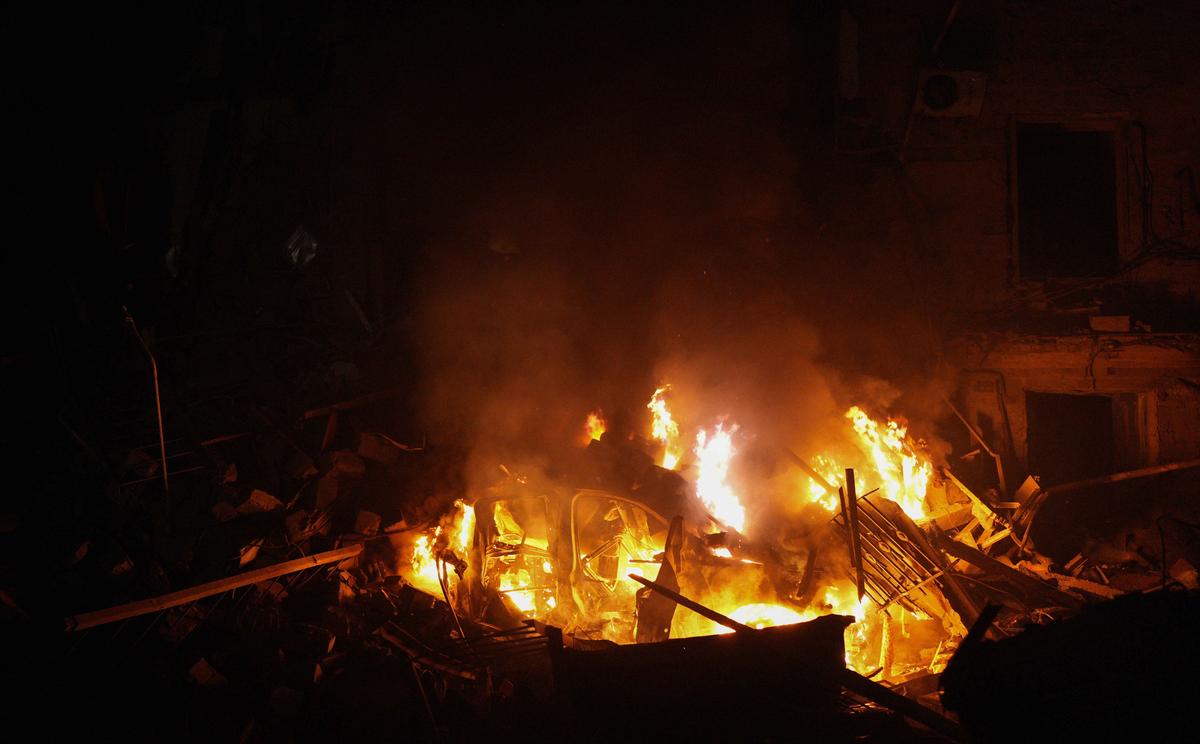
A car is engulfed in flames near a destroyed residential building on February 02, 2023 in Kramatorsk, Ukraine. Photo: Serhii Mykhalchuk / Global Images Ukraine / Getty Images
2.1.2 Artillery shelling and aerial strikes on roads
First Chechen War. With the outbreak of hostilities, bombing and shelling forced hundreds of thousands of people to flee dangerous areas. Each new outbreak of fighting spawned new crowds of people traversing the territory which the federal troops did not control and where a real hunt for vehicles would begin. Since the Chechen formations had practically no military equipment and did not use military vehicles for movement, the federal troops looked for fighters in any civilian vehicle — i.e. they carried out indiscriminate attacks[12].
Sometimes, in order to prevent civilian deaths, the command of the federal forces did provide a “corridor” for civilians to exit, but as a rule, the organization of the “corridors” was highly unsatisfactory — people were poorly informed about the existence of the “corridors” or were not informed at all; they were given little time to exit. It was not uncommon for civilians to die while using such “corridors”.[13]
Second Chechen War. Strikes on everything that moved along the roads, accompanied by the mass deaths of civilians trying to leave the bombing and fighting zone, were also carried out at the beginning of the Second Chechen War[14].
In fact, the simultaneous strikes on columns of refugees in various parts of Chechnya prove that these were not random excesses of the perpetrators, but the result of a systematic unwillingness of the high command of the Russian armed forces to take measures to ensure the safety of the civilian population during the hostilities. Similar events, albeit on a smaller scale, occurred later on in other parts of Chechnya, for example, in early February 2000, when people were trying to leave the village of Katyr-Yurt which was blockaded by federal troops and shelled.
Such attacks were common during the operation of Russian troops in Syria[15] and during the war in Ukraine[16].
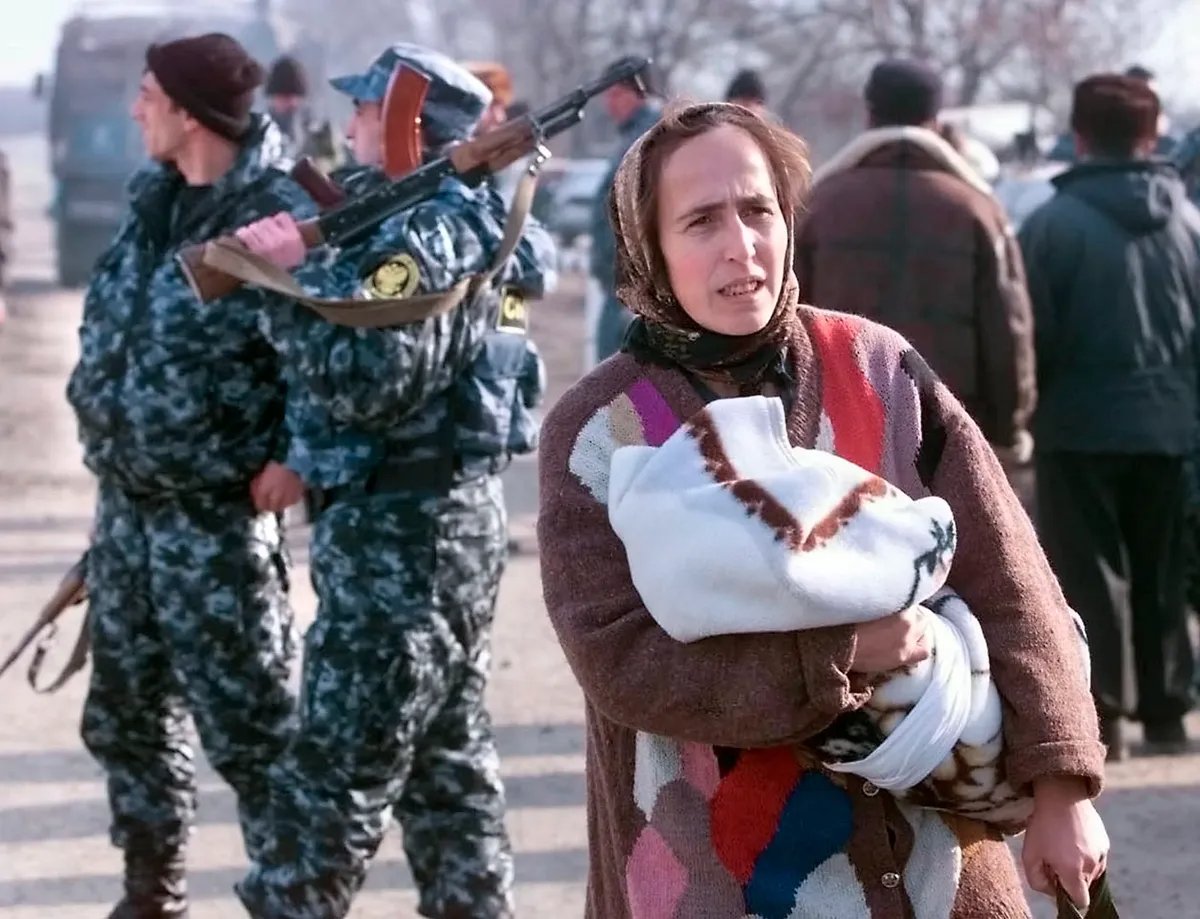
Chechen woman carries her child, passing by Russian soldiers on her way to the refugees camp on the Chechen-Ingush border, 1999. Photo: EPA / YURI KOCHETKOV
2.1.3 Assaults on populated areas
First Chechen War[17]. The largest number of civilians during the First Chechen War appear to have been killed in Grozny at the beginning of the assault in late December 1994 and during the fighting that lasted until the end of February. This conclusion is based on the results of the work of the Memorial in the combat zone and on the results of surveys of the refugees who left the city between December and March 1995.
Both sides used all the weapons they had, but the Chechen side was armed with only several artillery, anti-aircraft artillery and MLR systems, which were almost immediately destroyed. Federal artillery and multiple rocket launchers fired indiscriminately into residential areas. Federal aviation pounded the city with missiles and bombs. Federal soldiers deployed in residential buildings and fired at similar positions occupied by the Chechen formations.
Neither side took into account the safety of civilians, most of whom had not had time to leave the city and were hiding in the basements of the houses occupied by the combatants.
State structures of the Russian Federation did not count the deaths of Chechen residents, and the only estimates made by Memorial were then used by Rosstat. In the winter and spring of 1995, a survey was conducted in places where migrants who had left Chechnya (and went to Ingushetia, Dagestan, and Central Russia) using a methodology adapted by E. A. Gelman, followed by processing and extrapolation, which gave not only the number of deaths by cause of death, but also the dynamics of how people were leaving the city. The estimates of the number of deaths, based on the results of processing each group of questionnaires were quite close, the final estimate: from 25 to 29 thousand dead[18] in December 1994 — March 1995.
Second Chechen War. Russian federal forces had approached Grozny by early December 1999 and blockaded the city. On December 6, 1999, flyers with an ultimatum to “those defending Grozny” were scattered over Grozny. The demand was to abandon Grozny by December 11: “Those who stay in the city will be considered terrorists and bandits. They will be destroyed by artillery and aviation. <…> All those who have not left the city will be annihilated.” The media, quoting the OGV(s) headquarters, reported that long-range bomber aircraft Tu22M3 carrying vacuum (volume-detonating) bombs, a weapon of great power, would be used.
Since the fall of 1999, the Russian leadership had been stating that there was no armed conflict in Chechnya, but rather a “counter-terrorist operation”. The main goal of such operations is to save the lives of civilians, and then to destroy the terrorists, the basic principle being selectivity. By issuing this ultimatum, the federal command publicly renounced any observance of humanitarian law, in particular any selectivity in Grozny after the expiration of the ultimatum. Numerous deliberate attacks on civilians by Russian soldiers in Grozny and its suburbs when troops entered them in January-February 2000 illustrated exactly this approach[19].
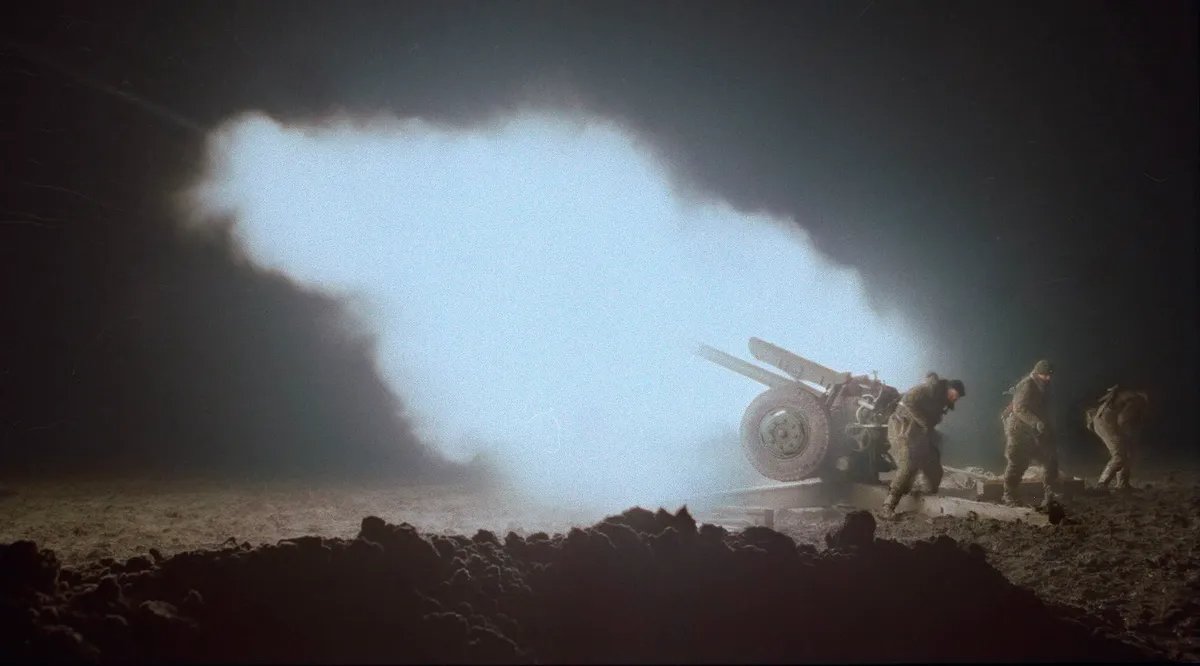
Russian soldiers shell the positions of Chechen fighters in Grozny suburbs, 1999. Photo: EPA / STRINGER
On the specifics of the Russian military operation in Syria. With few exceptions, we do not have sufficient and reliable information about episodes in which Russian security forces committed direct violence against civilians (murder, “cleansings”, enforced disappearances, “secret prisons”, torture, extrajudicial executions, etc.). This is the result of not only subjective circumstances such as the impossibility for Russian human rights defenders to work “on the ground”, but also by circumstances that are quite objective. The Russian presence in Syria was ensured mainly by aviation (including long-range) and navy forces, which practiced strikes against ground targets with both long-range missiles and bomb attacks. Ground forces were also present, in the form of artillery, engineering and RXBZ (chemical defense) units. Neither those forces nor the artillerymen, nor the aviation spotters who were on the ground were involved in contact combat or cleansing operations by virtue of their status.
Private military companies, primarily Wagner, were used in ground operations. Still, their presence was minor compared to the formations and units of the Syrian Army, Iranian formations, and pro-Iranian militias.
Finally, the units of the “special operations forces” that took part in raids behind enemy lines evidently acted according to their own prescribed and established methods, regulations, instructions, and traditions (it suffices to recall the story of Ulman’s group in the Chechen mountains in January 2002, see Chapter 2.6). But, for obvious reasons, we have no reliable evidence of this: the special ops leave no witnesses.
War in Ukraine. During the full-scale invasion of Ukraine that began on 24 February 2022, Russian and Russian-controlled forces (hereafter Russian troops for simplicity) stormed a number of locations, the largest of which was Mariupol[20], but there were also a number of assault operations, both successful (Volnovakha, Severodonetsk, Lisichansk) and unsuccessful (Kiev and Kharkiv). During all these operations, Russian forces carried out indiscriminate shelling and bombing of residential areas in the advancement zone (examples are given in the previous sections).
Mariupol’s population (457,000 in 2020) is comparable to Grozny. On March 2, Russian troops encircled the city and began an assault; fighting continued until May 16. Civilians were trapped inside the city. Electricity, water, heating and communication services were immediately compromised. In the conditions of incessant assault, the inhabitants had a hard time surviving in sub-zero temperatures, hiding for weeks in basements, suffering a shortage of food, water and medicines and not being able to leave the city safely. Russian artillery and aviation launched massive strikes on the city, destroying homes and civilian infrastructure.
According to the UN, up to 90 percent of apartment buildings and up to 60 percent of private homes were damaged or destroyed in the fighting.
The exact number of Mariupol civilians killed is unknown. Ukrainian authorities estimate that there were at least 25,000 victims, of whom 5,000-7,000 died under the rubble of their own homes. The Associated Press Agency, having analyzed satellite images from early March through December, noted at least 10,300 new graves in and around Mariupol. Some graves are marked with more than one number, indicating the burial of more than one person. In the months following the end of the fighting, satellite images record new graves as the rubble is cleared.
Russian authorities hindered the evacuation of civilians from the surrounded Mariupol to Ukrainian-controlled territory. Instances of organized evacuations to Ukrainian-controlled areas were rare exceptions. Russian troops provided buses only to those going deep into Russian-controlled territory.
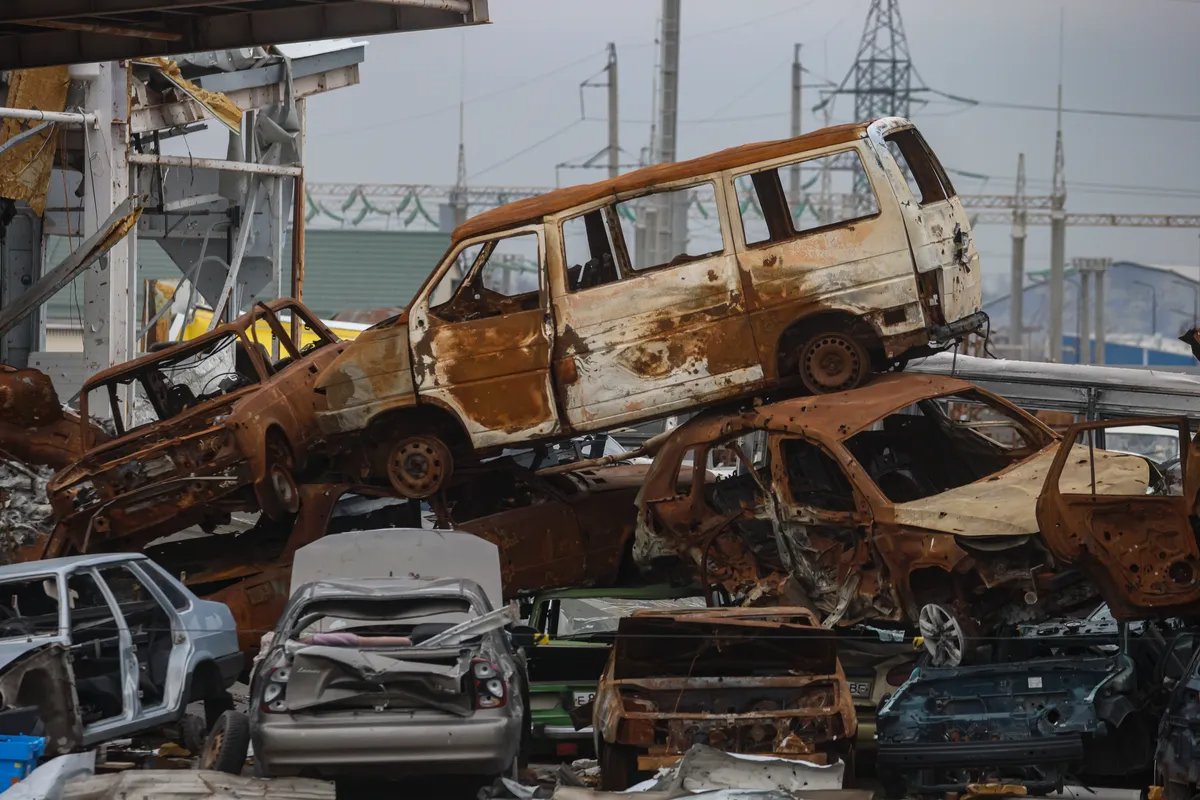
Destroyed vehicles are piled beside a shopping mall which was destroyed during fighting in Mariupoll, Ukraine, 2022. Photo: EPA-EFE / SERGEI ILNITSKY
2.1.4 The use of indiscriminate weapon systems, unavoidably causing heavy civilian casualties
First and Second Chechen Wars. During the Chechen wars the Russian army was repeatedly in a situation where Chechen forces were located in populated areas and when planning operations to take cities and villages, it was necessary to make provisions to protect civilians by limiting the use of weapons, especially high-powered and indiscriminate systems. However, the experience of World War II, the subsequent military build-up, and the more recent practice of the war in Afghanistan, which many Russian army officers had gone through, were not conducive to such self-restraint. The first target was Grozny, a city with a population of about 400,000, roughly equal to that of Mariupol, and slightly larger than that of eastern Aleppo.
During the First and Second Chechen wars, the indiscriminate nature of the strikes was express not only through the method of warfare itself, but also through the use of weapons systems and types of munitions with a known indiscriminate effect which inevitably led to large civilian casualties whenever they were used in populated areas that had not been abandoned by the inhabitants. Russian officials at various levels have repeatedly stated that to prevent civilian casualties, troops were, first of all, using modern precision-guided weapons, and, secondly, they were using it only for strikes on military targets. However, even if such weapons were being used, they were clearly not on a scale that would noticeably increase the accuracy of targeting and rule out indiscriminate fire and indirect bombing[21].
We will also note specific counter-terrorist operations in the narrow sense of the word, where, due to the indiscriminate actions of the federal forces and special forces, the freeing of hostages actually turned into operations to eliminate terrorists at the cost of the lives of hostages[22].
The operation of Russian forces in Syria. During the armed conflict in Syria, Russian armed forces used indiscriminate weapons systems, primarily cluster and incendiary munitions.
AI estimates that after September 30, 2015, the official start date of the Russian military operation in Syria, reports of the use of cluster munitions increased dramatically in precisely those areas where Russian troops were operating.
HRW has documented flyovers by Russian aircraft in cluster munitions-stricken areas around the time of the respective strikes[23].
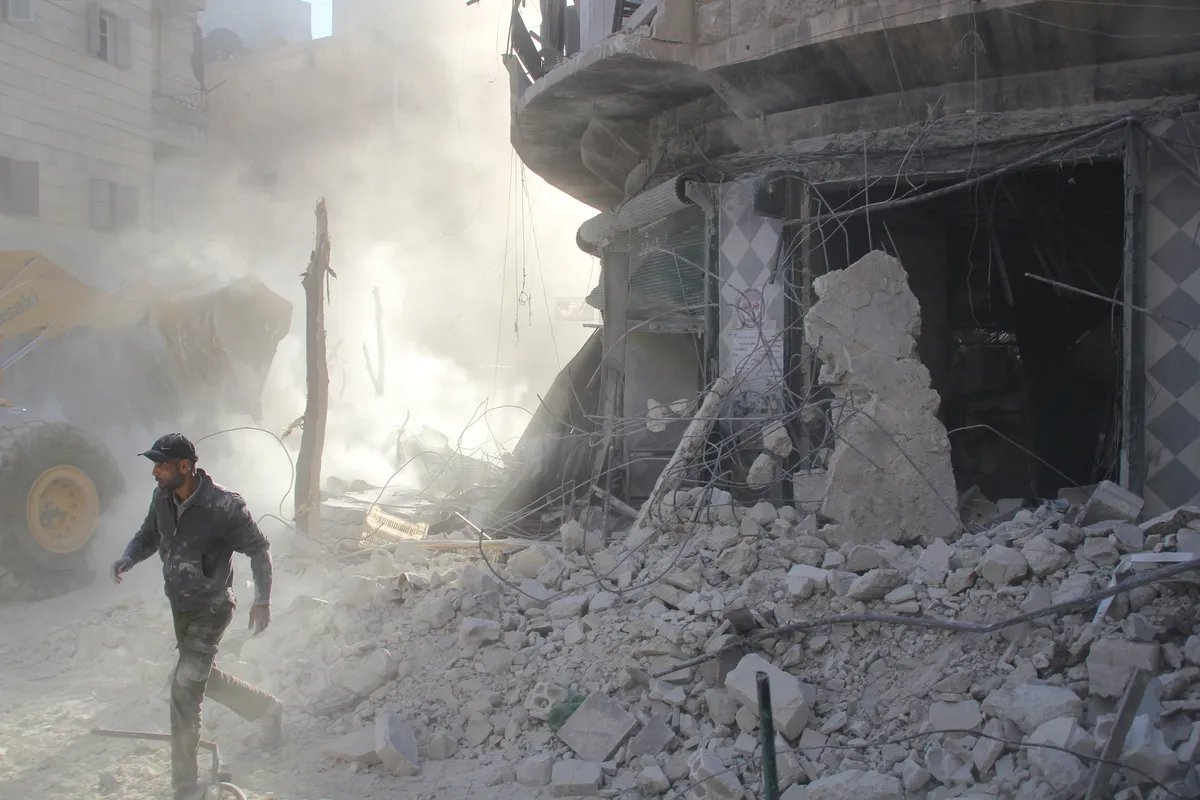
Aftermath of the bombing of Aleppo, November 2015. Photo: NurPhoto / NurPhoto / Getty Images
War in Ukraine. The use of cluster munitions by the Russian army during the invasion of Ukraine was massive. According to HRW, the Russian side used cluster munitions hundreds of times, with at least 689 civilians killed between February and July 2022. The Cluster Munition Coalition has documented the use of cluster munitions in Dnipropetrovsk, Donetsk, Zaporizhzhia, Luhansk, Mykolaiv, Odessa, Sumy, Kharkiv, Kherson, and Chernihiv regions[24].
2.2 Deliberate Attack on Civilian Objects and the civilian population
2.2.1 Artillery, aerial and rocket attacks on civilian targets
First Chechen War. Throughout the First and Second Chechen Wars, civilians suffered not only from indiscriminate fire, but also from deliberate strikes against civilian objects and residential neighborhoods that were known not to contain military objects[25].
The Russian military operation in Syria. Throughout the Syrian operation of the Russian armed forces, international observers recorded strikes on facilities known to be civilian, such as hospitals, markets, schools, mosques, etc. Many of the facilities attacked were on a list created as part of the agreed UN “conflict resolution mechanism” (hereinafter the “UN list”). The coordinates of the sites on this list had been given to authorities in Russia, Turkey, and the U.S.-led coalition in Syria to rule out accidental or allegedly random attacks. In May 2019, U.N. officials said the Russian and Syrian governments deliberately bombed eight hospitals in Idlib whose coordinates were on the list. Officials and the Defense Ministry denied everything. An October 2019 investigation published by The New York Times proved Russian air force involvement in the attacks.
According to an Amnesty International (AI) report, between April 30, 2019 and February 29, 2020, Russian and Syrian forces struck 53 medical facilities and 95 schools.
In October 2020, HRW published a report: in 11 months of Syrian-Russian offensives in Idlib, 46 military attacks were documented, at least 224 civilians were killed, and 561 people were wounded. HRW claims the Syrian-Russian strikes on hospitals, schools and markets in Idlib appear to be part of a deliberate military strategy to destroy civilian infrastructure and force residents to leave in order to make it easier for the government to regain control of the area. The offensive displaced 1.4 million people[26].
War in Ukraine. The most massive, systematic, and targeted rocket attacks on Ukraine’s energy infrastructure happened in late 2022. These attacks and the resulting disruptions in water and heating supply have been hitting the civilian population first and foremost, given that they began in the fall and escalated at the beginning of winter. The motives voiced by Russian officials are revenge for military failures and attempts to force the Ukrainian authorities to comply with Russian demands by terrorizing the civilian population, the latter being a war crime[27].
2.2.2 Deliberate Attacks against Civilians
First Chechen War. Among the many episodes, we should mention one that has become a symbol of such crimes: numerous premeditated attacks on civilians were carried out in the village of Samashki on April 7-8, 1995, after which the word “cleansing” acquired an ominous meaning. The death toll of 103 villagers, including 13 girls and women and 20 men over 61 years of age, has been reliably established. At least half were deliberately killed rather than killed by indiscriminate fire.
A year later, in March 1996, the federal troops made a second attempt to establish control over Samashki but met stubborn resistance from a Chechen Republic armed group located there. Fighting in the village lasted more than a week, killing at least 35 civilians.
Second Chechen War. In January and February 2000, the Russian military (here and below we also refer to the soldiers of the MVD and the various units of the Interior Ministry), as they took control of Grozny, carried out numerous attacks on the civilian population[28].
The war in Ukraine. Reports of deliberate attacks on civilians by the Russian military have been coming in since the first days of the full-scale invasion. However, serious investigation and documentation of what happened became possible mainly after the Russian troops retreated and independent investigative teams gained access to evidence[29].
2.3 Ill-treatment of detainees, unlawful detentions and unlawful places of detention, enforced disappearances, extrajudicial executions
During the First and then the Second Chechen wars, the federal law enforcement agencies created, step by step, a special system of places of detention and arrests. It combined both legal and officially recognized but illegal places of detention, and finally, illegal and secret places of detention. This system changed and evolved over time, but its essential attributes were cruel treatment, torture, enforced disappearances, and extrajudicial executions[30]. This system reached its peak in the early years of the Second Chechen War, when the majority of persons who had been abducted or illegally detained disappeared without trace — that is, became victims of extrajudicial executions.
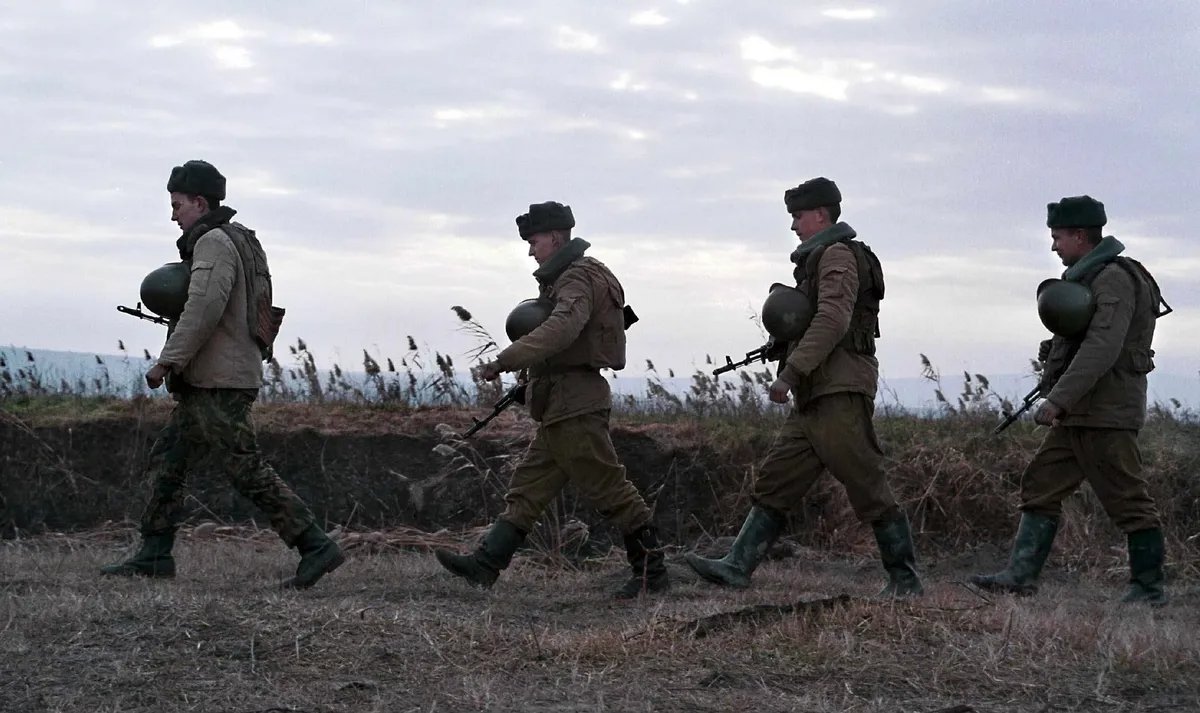
Russian soldiers march towards the Chechen capital Grozny, 1999. Photo: EPA PHOTO
War in Ukraine. Violations of the rights of civilians by Russian security forces in the occupied territories of Ukraine are brutal, widespread, and pervasive. Reports of abductions, disappearances, intimidation and psychological pressure, torture, beatings, and even murders have been coming from all the occupied territories. However, detailed and reliable information, obtained with the participation of international NGOs, appear only after the Ukrainian army has liberated these territories.
2.3.1 Unlawful detentions, detention facilities, torture and ill-treatment
First and Second Chechen Wars. The detention system was based on the so-called filtration points (FPs) — both stationary, which functioned for a long time, and temporary, created for the duration of a particular operation by the group conducting it. Some of the FPs gained official status, while others operated virtually illegally, and the security agencies denied their very existence[31]. In any case, the existence of any of these FPs directly contradicted the norms of the law[32].
With the outbreak of the Second Chechen War, this practice resumed on a new, more systematic level[33].
According to conservative estimates, the total number of people who have passed through the “filtration system” is close to 200 thousand — for Chechnya, where less than a million people lived in those years, this was a huge figure and proof of large-scale state terror.
In 2003, the Russian leadership began a policy of “Chechenization” of the conflict by creating pro-Moscow armed formations consisting of ethnic Chechens, and gradually delegating them the task of confronting the armed supporters of independence of Chechnya — and the right to illegal violence. The number of “cleansing operations” and, accordingly, the rate at which FPs were created decreased significantly. The old and customary places of detention were replaced by new ones, in the places where the Chechen pro-federal power structures were stationed[34].
War in Ukraine. The actions of Russian security forces on the territory of Ukraine, called “filtration,” and the facilities referred to as “filtration camps”, were very different from what used to be called by this word in Chechnya, both in purpose and in method.
According to U.S. government sources, Russia had been preparing to “filter” the population in Ukraine even before the full-scale invasion. There was no “situational design”, like in the First Chechen War.
This approach is reminiscent of the methodology developed in the 1940s, when the concept of “filtration” and “checking and filtering” camps emerged.
But the main component of the “filtration” process was archival and analytical work that resulted in the emergence of archives of filtration cases maintained by the Soviet state security agencies which included many millions of individual personal files.
The meaning and content of the term “filtration camp” should be clarified. The first reports of “filtration camps” in Ukraine appeared in mid-March 2022 in connection with the mass migration of the population — if not forced, then at least involuntary. Most of the “filtration” events took place in the south of Ukraine, and most of the information about those subjected to filtration relates to the period of the siege of Mariupol. There is evidence of 15 and even 21 “filtration camps”. The “filtration” mainly concerned those who were leaving Mariupol for Russia. There is no official information about the total number of the “filtered”, but according to indirect data these are many hundreds of thousands of people.
The “filtration” usually took place at the police station, or in an adapted room, such as a house of culture, or even in a temporary tent camp. Representatives of the security services asked a number of questions, often making people fill out a questionnaire about their relatives, work, political views, and ties to the Ukrainian armed forces or the authorities. People were photographed from front and back, and finger and palm prints were taken with a special tablet. Cell phones were confiscated, and their contents were checked, including contact lists, messages and photos. In some cases, the IMEI of the phone was recorded. Some men were forced to undress in order to see if they had any tattoos indicating their affiliation with the Armed Forces or radical right groups, or bruises from carrying weapons. Most of those who underwent “filtration” received a certificate at the end. In fact, this type of “filtration camps” was not a place of imprisonment or restriction of freedom — they could more accurately be called “extended checkpoints”. The ten-day waiting period that became commonplace was not due to malicious intent, but rather to their limited, especially by compliance with increasingly complicated formalities, capacity.
In terms of regime, these were not “camps”, but rather “colonies” — but the system was quite consistent with the idea, process, and system of “filtration” in the darkest sense.
Little is known about those who, for one reason or another, did not pass the screening at the “filtration point”. They were detained in DNR-controlled territory. Some were probably victims of enforced disappearances. Thousands of Ukrainian civilians were forcibly detained by Russian security forces without any legal basis. Official Ukrainian sources claim that those who did not pass the “filtering” were detained for 36 days in “DPR”-controlled territory for interrogations, and then either released or tried.
Those suspected of having ties to the Ukrainian military or law enforcement agencies were detained at “filtration points” and sent to the colony in Yelenivka for the duration of their administrative arrest. There, local security forces tried to find out more — specifically, whether the person was related to the army, police, territorial defense, or the Azov regiment. As a result of the “check”, the person was either released or put on trial. People detained during the filtration process may have been subjected to torture and other forms of ill-treatment in detention (in some cases, they were victims of enforced disappearances)[35].
2.3.2 Treatment of Detained members of armed groups
First and Second Chechen Wars. The fate of the imprisoned fighters of the armed formations of the self-proclaimed Chechen Republic of Ichkeria or other formations that opposed the Russian forces, and of those against whom such suspicions were raised, was not enviable. In any case, their treatment was extremely cruel, and most of them were killed or disappeared without trace.
During the First Chechen War the situation was even worse than during the Second Chechen War: not less tragic, but rather less well-known. People who, according to the security forces, certainly belonged to the armed formations of the self-proclaimed Chechen Republic of Ichkeria or to other formations opposed to the Russian forces were not always brought to the FPs but were usually either handed over from illegal detention facilities for exchange or killed after a “forced interrogation”. Their treatment was brutal, which sometimes disrupted the exchange process[36].
The number of captured fighters of the Chechen Republic of Ichkeria in the first six months of the second Chechen war reached many hundreds, which was not the case in the first war. Since the initial intention was to process them as part of a criminal case, those who were not killed soon after their arrest were placed in temporary detention facilities and pre-trial detention centers in the North Caucasus region. The treatment of those placed in pre-trial detention facilities was brutal, but the first days after detention were much scarier[37].
The operation of Russian troops in Syria. Linear units of the Russian Army were little involved in combat operations directly and had virtually no contact with prisoners of war. The “closest” contact with the enemy on the battlefield was made by paramilitary units known as the Wagner PMC[38].
War in Ukraine. Reports of Ukrainian prisoners of war being tortured, abused, and subjected to cruel, degrading treatment have been coming since the beginning of the massive invasion of Ukrainian territory by Russian troops in February 2022[39].
2.3.3 Enforced disappearances and extrajudicial executions
First and Second Chechen Wars.
Enforced disappearances and extrajudicial executions are two components of the same criminal practice, inextricably linked. Kidnapping, often after having been held in an illegal “secret prison” and almost always after torture, was frequently followed by a non-judicial execution[40].
All this the criminals sought to conceal (more or less thoroughly), which resulted in the fact that the fate of the abductees remained unknown, at least for many years. During the Second Chechen War, the practice of enforced disappearances involving extrajudicial executions became widespread, acquiring the nature of an established system of state terror[41]. It was organized and coordinated by representatives of various state security agencies. Such actions constitute crimes against humanity which have no statute of limitations. Memorial can state that more than three thousand people disappeared without a trace (or their bodies were later found) as a result of abductions, illegal arrests and detentions during the CTO in 1999-2009 — it is not yet possible to provide more precise figures.
These practices were continued during the war in Ukraine[42].
2.4 “Cleansings” of settlements
Zachistka or a “cleansing” is when “special operations check the registration of people at their place of residence and identify members of illegal armed groups”, during which a settlement is blockaded, and then a house by house search is conducted and all suspicious people are detained[43]. “Cleansings” of settlements were a common practice during the Afghan war. As a rule, Soviet troops blockaded settlements or urban quarters with internal troops, while special services of the pro-Soviet Afghan puppet government operated inside them.
On the outskirts of the cleansed settlements, “filtration points” were set up, where all suspected of ties with the “Dushmans” were taken and where they were interrogated and sorted.
First and Second Chechen Wars. The Afghan experience of “cleansings” came to be of use during the First Chechen War[44].
The “cleansings” took their final and systemic form during the Second Chechen War in 2000-2003[45].
In the second half of 2000, large-scale hostilities were replaced by guerrilla warfare, with repeated “cleansings” in federal-controlled territory accompanied by violence and looting. An important feature of the “cleansings” pf 2000-2003 were mass indiscriminate detentions in temporary “filtration points” (see section 2.3.1. above)[46].
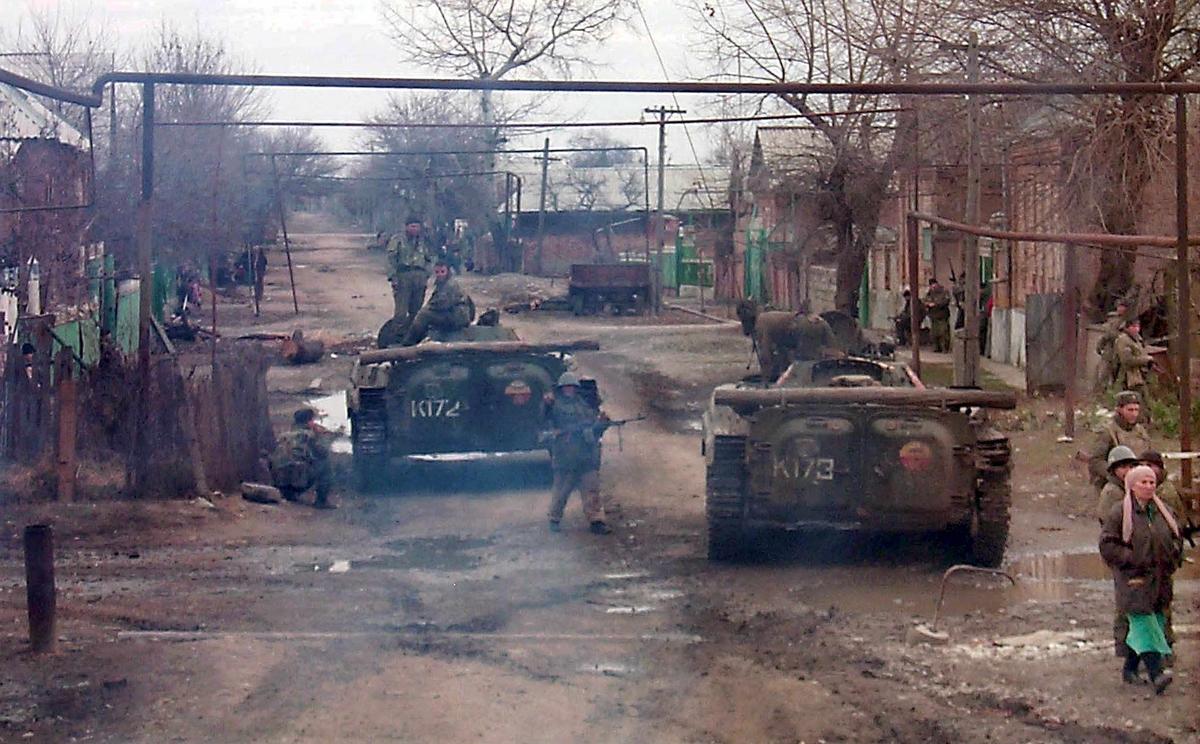
Russian federal troops enter the Chechen village of Samashki, 1999. Photo: EPA PHOTO / STR
War in Ukraine. After February 2022, there were no reports of “cleansings” along the lines of the First and Second Chechen Wars, but elements of these practices were noticed almost everywhere in the occupied territories, where Russian authorities carried out special operations to neutralize disloyal citizens[47].
2.5 Use of hostages and human shields
During the First Chechen War there were documented cases of federal forces using civilians as hostages and “human shields” — episodes that build up into a system[48]. Although the most famous such crime, i.e. the hostage-taking in Budyonnovsk on June 14-19, 1995, was committed by Chechen terrorists under the command of Shamil Basayev, it should not be forgotten that both Basayev himself and many of his fighters had been trained in Abkhazia under the guidance of GRU officers and airborne special intelligence units.
Memorial has documented repressions against family members of suspected fighters as well as imposing collective responsibility and collective punishment — but rather as isolated episodes explained either by revenge or attempts to obtain information about those fighting against the Russian forces, rather than as a system.
Since 2004, in the course of the “Chechenization” of the conflict, with the participation, support and protection of the federal center, hostage-taking, arson and house-bombing, murder and other forms of repressive actions against family members of combatants became common and systemic.
This practice was one of the main methods by which the Kadyrov clan consolidated its power, suppressed resistance and formed its own paramilitary structures.
2.6 Investigation of crimes against civilians and captured members of armed groups
Investigation of crimes committed by security services against civilians and captive combatants during the First and Second Chechen wars can be labelled as “selective impunity”. Crimes committed by fighters of the self-proclaimed Chechen Republic of Ichkeria and other fighters who opposed the federal authorities were investigated and received harsh sentences. Investigations into such crimes continued many years after the end of the armed conflicts, and new arrests in such cases were made as later as 2020-2022[49]. Investigations of crimes committed by state agents were sabotaged. And if by 1997 (for the events of the First Chechen War) or by 2006 (for the events of the Second Chechen War) the investigation of such an act of crime had not been completed, it was arguably suspended and never resumed.
During the First Chechen War, in most cases investigative agencies did not initiate criminal proceedings or even conduct pre-investigation checks. By the beginning of the Second Chechen War, Russia had become a member of the Council of Europe, ratified the European Convention for the Protection of Human Rights and Fundamental Freedoms and recognized the ECtHR’s jurisdiction. It was the victims’ and victims’ relatives’ complaints to the ECtHR that usually prompted the Russian investigative authorities to initiate criminal proceedings. As a rule, no effective investigation followed. All ECtHR judgments issued in response to complaints from residents of the Chechen Republic point to the lack thereof.
None of the top commanders have been punished for the criminal acts of the federal forces in Chechnya and the surrounding regions during the First and Second Chechen wars. No one has been punished for the actions of federal forces that led to mass deaths of civilians and destruction of civilian objects: indiscriminate fire and indirect or deliberate bombing, shelling and rocket attacks on civilian objects. Only a few criminal cases have been initiated over the bombing of villages during the First Chechen War, none of which have been investigated to completion[50].
The same thing happened during the Second Chechen War. No punishment was ever handed down for the 1999-2000 artillery and bombing attacks on residential areas where there were civilians or on the roads where columns of refugees were passing. Criminal proceedings were not even initiated in most of these cases. A few exceptions are related to the fact that several victims filed complaints with the European Court of Human Rights. Only after the complaints were commuted by the Court, criminal proceedings were initiated, but the perpetrators were not found and punished[51].
No one has been held criminally responsible for deliberate attacks on civilians and civilian objects during military and special operations of the First Chechen War. Most often, criminal cases were not even opened[52].
During the First Chechen War, no one was held criminally responsible for the creation of “filtration points”, which is not provided for by the laws of the Russian Federation, or for the forced confinement of citizens, for the cruel and degrading treatment of detainees and arrestees, and for the use of torture. We know that, based on the results of departmental inspections, some of the heads of “filtration points” were disciplined, but no more than that[53].
No one was prosecuted for taking hostages and using civilians as human shields (see Section 2.5.).
When it comes to the events of the Second Chechen War, for thousands of crimes — illegal detentions, torture, enforced disappearances, extrajudicial executions — few sentences have been handed down by Russian courts[54].
- Russian aggression in Ukraine, i.e. the annexation of Crimea, the “hybrid war” in the eastern regions of the country, began in 2014. Even then, Memorial called these actions aggression, according to the UN definition; for this statement, Memorial International was declared a foreign agent in 2016).
- The Soviet invasion of Hungary in 1956 and the entry of Warsaw Pact troops into Czechoslovakia in 1968 were comparable to this war in terms of the number of troops involved but were not accompanied by combat operations on any comparable scale. The war in Afghanistan, which cost up to a million and a half Afghan lives and was one of the reasons for the Soviet collapse, began in 1979, took place not in Europe but “somewhere in Asia”. In the Balkan wars of the 1990s on the territory of the former Yugoslavia (whose fate the former Soviet Union seemed to have avoided at the time) Russia was not directly and extensively involved (however, the participation of Russian “volunteers” from the beginning and the presence of “peacekeepers” towards the end of these wars, in both cases not too many, was essentially important).
- The report reviews the genesis of the post-Soviet “hot spots” and the development and interrelationship of the armed conflicts of 1988-1993.
- This is known with certainty after the Polish authorities declassified the archives of the Warsaw Treaty Organization in 2005.
- Here is an admittedly incomplete list of cities, towns, villages and villages in Chechnya that have suffered from shelling, bombing and rocket attacks: Avtury, Agishty, Alleroy, Alkhazurovo, Alkhan-Kala, Alkhan-Yurt, Argun, Assinovskaya, Achkhoi-Martan, Bamut, Bachi-Yurt, Benoy, Berdakel, Valerik, Vedeno and villages of Vedeno district (Belgatoi, Dyshne-Vedeno, Dargo, Kharachoi, Elistanzhi, Tsa-Vedeno, etc.), Verkhatoi, Germenchuk, Gekhi, Gekhi-Chu, Goyty, Goyskoye, Grozny, Gudermes, Dachu-Borzoy, Dolinsky, Duba-Yurt, Ermolovskaya, Zakan-Yurt, Zandak, Ilaskhan-Yurt, Itum-Kale, Ishkhoi-Yurt, Kadyr-Yurt, Komsomolskoye, Koshkeldy, Martan-Chu, Makhkety, Naibere, Niki Khita, Novoartemovo, Novogroznensky, Novye Atagi, Nozhay-Yurt and the villages of the Nozhay-Yurt district (Betty-Mokhk, Galaiti, Zamay-Yurt, Meskety, Sogunti, Tsentoroi, Shovkhal-Berd and others).), Oktyabrskoye, Orekhovo (Yandi), Pervomayskaya, Petropavlovskaya, Prigorodnoye, Roshni-Chu, Samashki, Serzhen-Yurt, Sernovodsk, Staraya Sunzha and Starye Atagi, Stary Achkhoi, Suvorov-Yurt, Tangi, Urus-Martan, Kharsenoi, Tsentoroi, Chechen-Aul, Chiri-Yurt, Chishki, Shalazhi, Shatoi, and villages of the Shatoi district (Zony, Yaryshmardy, and others), Shelkovskaya and Engel-Yurt.
- Examples: the bombing and shelling of Grozny and its environs in December 1994. Lies of the military and political leadership.
- Examples: the strike on Grozny with Tochka-U missiles on October 21, 1999. Lies of the military and political leadership. Failure to investigate this crime.
- Examples: “Operation Wolf Hunt”, February 2000, bombing and shelling of the village of Katyr-Yurt. ECtHR decisions in Isayeva v. Russia (Complaint No. 57950/00), Abuyeva and Others v. Russia (Complaint No. 27065/05), Abakarova v. Russia (Complaint No. 16664/07), 10th Annual Report of the Committee of Ministers on monitoring the execution of ECtHR decisions; communicated complaint “Abuyeva Marusya v. Russia” (No. 63329/14).
- Example: an air strike on the village of. Rigakhoi on April 8, 2004.
- Examples: air strikes in the fall of 2015 and in 2019.
- Examples: the list of attacked settlements; strikes on Kharkiv and Chernihiv; the March 9, 2022, strike on Hospital No. 3 in Mariupol; the April 8, 2022, strike on the railway station in Kramatorsk, Donetsk region, with a Tochka-U missile.
- Examples: the actions of the 67th separate GRU Special Forces brigade; the attack at Novy Sharoy in December 1994; the journalists' testimonies; the attack at Mesker-Yurt, spring 1995; the attack at Vedeno, 30 June 1995.
- Examples: the “Shatoi corridor” in May 1995; the strike at Goyty on 20 August 1996.
- Examples: srtikes on 29 October 1999 near the village of Shaami-Yurt (ECtHR judgment in the case of Isayeva, Yusupova and Bazayeva v. Russia, Applications nos. 57947/00, 57948/00 and 57949/00) and near Goryacheistochnenskaya station.
- Example: the September 19, 2016 strike on a UN and Syrian Red Crescent Society (SRCS) convoy near Aleppo; lies by the political and military leadership.
- Examples: the shooting of the Maksimenko family’s car from Gostomel on February 28, 2022; firing on the road from Irpen to Kyiv on March 6, 2022; the shooting of a humanitarian convoy in Zaporizhia on September 30, 2022.
- Examples: “cleansing” operations in Samashki on April 7-8, 1995; fighting in the Argun Gorge on May 11 — June 14, 1995; fighting in Gudermes in December 1995; bombing, shelling, and flame throwing in different districts of Grozny in August 1996.
- With a 95% confidence level. Estimates of the total number of deaths in the First Chechen War give a larger range: between 30,000 and 50,000.
- Example: the organization of “humanitarian corridors” (“safety corridors”) for the civilian population to leave Grozny.
- Examples: strikes on the maternity ward at City Hospital No. 3 (see Chapter 2.1.1.) and the drama theater; the story of Mariupol resident O. Sagirova.
- Examples: strikes on Grozny in December 1994; the use of Grad, Uragan, and Buratino multiple-launch rocket systems. TOS-1 “Buratino” is a “heavy flamethrower system” — a multiple launch rocket system that fires thermobaric (“vacuum”, “volume explosion”, “fuel”) munitions that, over a large area (a volley covers 40 hectares), hit human force and equipment with high temperatures and a powerful shock wave. The high pressure and low-frequency component make the shockwave particularly lethal both at a distance from the detonation point and in field or long-term fortifications. “Area-based” systems of this type, when used in populated areas, result in indiscriminate civilian casualties. ECtHR judgment in Isayeva v. Russia (No. 57950/00); use of cluster bombs with ball and needle munitions in populated areas; use of volume blast bombs in populated areas.
- Examples: Budyonnovsk (June 1995), Kizlyar and Pervomayskoye (January 1996), Beslan (September 2004), the ECtHR judgment “Tagaeva and Others v. Russia” on seven complaints on behalf of 409 applicants.
- Examples: in 2015-2016 in Damascus, Idlib and Aleppo provinces; on July 11, 2016 Termanin in Idlib province; lies by officials.
- Examples: February 24, a “Tochka-U” rocket near the Central City Hospital in Ugledar, Donetsk region; April 15, Kharkiv.
- Examples: the missile and bombing attack on the village of Arshti (Ingushetia) on 3 January 1995. Arshti (Ingushetia) on 3 January 1995 and 18 April 1995; the bombing of Shali (Chechen Republic) on 3 January 1995; the bombing of Shali, Urus-Martan, Valerik and others in the spring and summer of 1996 during the campaign to sign “peace protocols” by the villages.
- Examples: six attacks from December 2015 to February 2016 in northern rural Aleppo province; air force strikes on May 5 and 6, 2019 in northwestern Syria, including Nabad al-Hayat, Kafr Nabl, Kafr Zita and al-Amar in Idlib province January 29, 2020 in Ariha, Idlib province, airstrikes on al-Shami hospital).
- Examples: strikes on September 11, October 10 and onwards, November 15, November 23.
- Examples: the events in the Staropromyslovsky district of Grozny: the ECtHR rulings in the cases of Khashieva-Akayev, Elena Goncharuk, Khedi Makhauri; the “cleansing” of the settlement of Novye Aldy: the Memorial Human Rights Centre report; the ECtHR rulings in the cases of Estamirov and Others v. Russia, Musayev and Others v. Russia and Khajimuradov and 16 other complaints against Russia; examples of “acts of retribution” on 21 November 2000 near Davydenko village, 11 December 2000 near Mesker-Yurt village, 15 March 2001 near Novogroznensky settlement; the “cleansing” of Borozdinovskaya village on 4 June 2005, ruling on complaints from 126 residents of Borozdinovskaya, Adzhigitova and others v. Russia.
- Examples: murders in Stary Bykov, Chernihiv region; murders in Bucha, Kyiv region.
- Of course, this system did not emerge from nothing. The army, internal troops and other power structures had to regulate all aspects of work with prisoners, internees, detainees, etc., in their statutes and instructions, in internal administrative documents. Moreover, by the mid-1990s the Soviet Army, the KGB, the GUITU and their successor structures had very recent experience of establishing such a system during the war in Afghanistan, about which there is sufficient evidence. The officer corps of the Russian power structures consisted to a large extent of those who had served in Afghanistan (which is understandable — they had received their ranks and made their careers in the war) and had relevant experience. Elements of this system can also be traced during the armed conflict in Nagorno Karabakh, where Interior Ministry troops and Anatoly Kulikov in particular participated (in May 1991 the Koltso operation was led by Anatoly Romanov, as well as in the cleansing of Samashki village in 1995), and during the autumn 1993 crisis in Moscow, where the security forces were led by the same senior officers of the MVD, including Kulikov and Romanov. They and other MVD officers then participated in the creation of the “filtration” system during the First Chechen War.
- The phrase “filtration point”, which was used by security forces in Chechnya, was encountered in responses from the prosecutor’s office, but does not exist in Russian legislation. In 2005 the “Manual on planning and preparation of forces and means of internal affairs bodies and internal troops of the Interior Ministry of Russia for actions in emergency situations”, Appendix №1 to the Interior Ministry Order № 870 dated September 10, 2002 became known to the public. The order itself was classified as “for official use” and was not published anywhere. The “Manual…” prescribed the creation of FPs during special operations. The disclosure of a secret document, suggesting the creation of FPs for holding people in custody, which is not stipulated by the law, caused a scandal. In the end, the text of the “Manual…” was changed by order of the Minister of Internal Affairs, the mentioning of the FPs was excluded. But we can be sure that this definition was still used in other internal documents of the Ministry of Internal Affairs and FSB, inaccessible to the public.
- Examples include the “stationary” FPs in Mozdok (1994-1995), the OPs in Stavropol, Pyatigorsk (Stavropol Krai), and Grozny; temporary filtration points; places of illegal detention in places of deployment of military units of the Ministry of Defense and the Interior Ministry troops, at the group headquarters near Assinovskaya station (1995) and at the military base in Khankala; ‘unequipped guardrooms’; torture.
- Examples: filtration points in Chernokozovo, Titanik and Khankala; temporary detention centers during “cleansing operations” in populated areas ; temporary detention centers set up under the district temporary departments of internal affairs (VOVD), including the Urus-Martanovsky and Oktyabrsky districts of Grozny; ECtHR decisions on the complaint of relatives of Zelimkhan Murdalov and on the complaint of Alaudin Sadykov.
- Examples: the illegal detention facilities in the village of Tsentoroy, where members of the Kadyrov clan resided; the temporary detention facility at the Operative-Investigative Bureau No. 2 (ORB-2).
- Examples: illegal detention facilities in the temporarily occupied territories of Kyiv and Chernihiv oblasts, in Kherson, and in Izium, Kharkiv oblast.
- Examples: exchange on January 26, 1995; exchange in February 1996 in Shatoi.
- Example: the fate of a group of combatants who surrendered in the village of Komsomolskoye on March 20, 2000.
- Example: the killing by the Wagnerites of Abdullah Elismail in 2017.
- Examples: the case of detained terrorist fighters and a local resident in Kherson on March 27; castration and murder of a prisoner by a “volunteer” of the “Akhmat” battalion Ochur-Sugue Mongush; murder of former prisoner Evgeny Nuzhin by members of Wagner PMC.
- Examples: databases of people who disappeared between 1994 and 1996; the detention and murder of A. Tretyakov and brothers M. and S.-E. Khamidov in 1995; the detention and murder of Sharyp Bataev, a resident of Arshty, in 1996.
- Examples: the history of the formation of the system of enforced disappearances; the mass grave in the former cottage settlement “Zdorovye”, ECtHR decisions on complaints of relatives of Nura Lulueva (Luluev and others v. Russia. №69480/01) and relatives of Markha and Raisa Gakaev (Ayub Gakaev and others v. Russia. No. 56745/08 in the case of Kayharova and Others v. Russia), in the case of Lyanova and Aliyeva v. Russia. No. 12713/02 and 28440/03; statistics, i.e., information on ECtHR judgments in Second Chechen War cases; a review of information by Memorial Human Rights Centre about those who disappeared during the Second Chechen War.
- Examples: information from the UN monitoring mission, including on the city of Bucha (100 murders, 57 of those qualified as executions, 30 of those in places of detention); detentions and killings in Kyiv region; mass graves in Izium, Kharkiv region; abductions and killings in Kapitolovka village of Izium district, Kharkiv region; information about detention in “secret prisons”, interrogations and blackmail; information on illegal transfer of detainees to Belarus and Russia; the story of Viktoria Andrush who was detained in Stary Bykov; information on conditions, torture, inducement to secret cooperation, threats to relatives; the story of the detainee “Anton” in Berdyansk, Zaporizhzhia region.
- In the USSR, at least until the 1950s, such operations were called “roundups”.
- Examples: cleansing operations in quarters of Grozny in December 1994-January 1995; the villages of Samashki on April 7-8, 1995, and in mid-March 1996; the town of Gudermes on December 20, 1995; the village of Novogrozny in February 1996, Some quarters of Grozny in March 1996; the district centers of Shali and Urus-Martan in April 1996; and the villages of Makhkety, Agishty, and Khatuni in July 1996 (see Sections 2.1.2 and 2.2.2).
- Examples: the “cleansing” operations in the village of Alkhan-Yurt in December 1999, the Staropromyslovsky district of Grozny in January 2000, and the village of Novye Aldy in February 2000, which were accompanied by massacres (see Section 2.2.2).
- Examples of “cleansings” and attempts to regulate them (or imitate regulations): Order No 145 of the commander of the grouping, 24 May 2001; the “cleansing” of Sernovodsk and Assinovskaya, Sunzhensky district, in July 2001.The “cleansing operations” in the villages of Starye Atagi, Alleroi, Novye Atagi, Chiri-Yurt, Duba-Yurt, Alkhazurovo, and others, and Order No. 80 of the group commander, March 27, 2002; the cleansing operation in the village of The “cleansings” in 2003-2006; the “cleansings” of Borozdinovskaya village (see Section 2.2.2) and the village of Zumsoy Itum-Kalinskiy (see Section 2.2.2). Zumsoy, Itum-Kalinsky district, 14 January 2005.
- Example: Bucha, Kiev region.
- Examples: taking the residents of Shatoi hostage on June 12, 1995; the use of “human shields” in the village of Samashki on March 15 and 17, 1996; the use of hostages during the battles in August 1996 in Grozny: in the “15th town” on August 11, 12 and 17; the seizure on August 10, 1996 of medical staff and patients of the hospital No. 9; the order to take hostages in the beginning of March 1996. The use of medical personnel and patients of Hospital No. 9 in Grozny; order to take and use hostages in Grozny in early March 1996; use of “human shields” during the Second Chechen War in the beginning of March 2000 in the battles near the village of Komsomolskoye.
- This topic — the investigation of crimes committed by members of armed groups of the Chechen Republic of Ichkeria — is beyond the scope of this report. Let us note that the investigative authorities primarily sought to show the result, i.e. to “solve” the crime at any cost and by any means: including the use of “unauthorized methods” in relation to those under investigation, falsification of evidence, and so on.
- Examples: the failure of the military prosecutor’s office to investigate the bombing of villages. The cases of Roshni-Chu, Gekhi-Chu, Shalazhi, Katyr-Yurt, and Chishki were suspended “due to the failure to identify the persons to be charged” or were terminated “due to the absence of corpus delicti”.
- Examples: the criminal cases concerning the shelling of the village of Katyr-Yurt on February 4, 2000 (see Section 2.1.1) and the air strikes on a column of refugees on the road near the village of ShaamiYurt on October 29, 1999 (see Section 2.1.2) were dropped “for the absence of a crime”; the only sentence, albeit suspended, was given in the case of Colonel P. in the artillery attack on the village of Gorgachy, Shatoi district, April 16, 2002.
- Examples include the dismissal of the case of the killing of civilians and deliberate destruction of houses in the village of Samashki on 7-8 April 1995 (see Section 2.2.2); the failure to investigate the murder or attempted murder of residents in Staropromyslovsky district in 1999-2000 (see Section 2.2.2); the failure to investigate the massacre of residents in the village of Novye Aldy in the adjacent district of Grozny on 5 February 2000; and the judgment of the European Court of Human Rights in the case of Musaev and Others v. Russia (complaint No. 1).The failure to investigate the massacre of residents on 5 February 2000 in the village of Novye Aldy and the adjoining Grozny district; the ECtHR judgment in the case of Musayev and Others v. Russia, Applications nos. 57941/00, 58699/00 and 60403/00, Musayev and Others v. Russia.
- Examples: the murder case in May 1995 of Musaev, Akhmadov and Dzhambulatov (at least one was held at a filtration point in Grozny, see Section 2.3.1); the failure to investigate the case of the detention of Samashki residents who fled gunfire from the village on 15 March 1996 (see Section 2.2.2); the failure to investigate the case of the abuse of a captive by FSB combatants (see Section 2.3.3). Section 2.3.3.); the only conviction for the shooting of a detainee on August 2, 1995 at a checkpoint; the prosecution and acquittal by the court of Colonel S.N. Sokolov in the case of the forced disappearance of three people on May 9, 1995; the failure to investigate the detention of Sharip Bataev near Arshty village (see Section 2.3.4).
- Examples: the only verdict for illegal detention, cruel treatment and torture: on February 4, 2001, Warrant Officer Ch. and Junior Sergeant M. beat citizens Satayev and Magomadov in the barracks; they were found guilty under Article 286 part Z clause “a” of the Criminal Code of the RF [Abuse of power, with the use of violence], the punishment for each was 3 years of suspended imprisonment with a probation period of 2 years; the verdict on the resonant “Cadet case” (formally it refers to the same category, in fact it is about an enforced disappearance): Senior lieutenant of the MVD Sergey Lapin was convicted on March 29, 2005 under Art. 111 (infliction of severe bodily injuries under aggravating circumstances), part 3, clauses a, b, c, article 286 and part 3, article 292 (forgery) of the Criminal Code of the Russian Federation for the forced disappearance of Zelimkhan Murdalov on 2 January 2001 and was sentenced to 10 years' imprisonment (through efforts by Natalia Estemirova, employee of the Grozny office of the Memorial human rights center, who was kidnapped in Grozny and killed in Ingushetia on July 15, 2009, along with journalist Anna Politkovskaya who was murdered on 7 October 2006 in Moscow, and lawyer Stanislav Markelov who was murdered on 19 January 2019 in Moscow); his acquitted accomplices Lieutenant Colonel Minin and Major Prilepin were granted amnesty in January 2016; for the “disappearance” of 17-year-old Rasul Jamalov, detained during a cleansing of the village of Alleroi on August 16, 2001, junior sergeant Mikhail Aleksandrovich Podolnov was sentenced to 10 years in accordance with part 1 article 105 of the RF Criminal Code (murder); this was possible because the murderer was a cousin of A.-Kh. Kadyrov. During the entire period of the Second Chechen war, only Colonel Yuri Budanov was officially convicted of kidnapping (in March 2000, he kidnapped Elza Kungaeva and brutally murdered her; the rape charge simply “disappeared” during the investigation); consequently, for the total number of enforced disappearances (from 3,000 to 5,000 people) we have two federal siloviki and two “kadyrovites” sentenced (the “ATC case” and the “PPS case”). i.e., the impunity rate for such crimes is 99.9 percent; a review of impunity methods for enforced disappearance cases; there are only two convictions for extrajudicial executions: on December 27, 2007 Lieutenant Arakcheyev and Senior Lieutenant Khudyakov were sentenced to 15 and 17 years in prison, respectively, for the murder of three Chechens; on June 14, 2006, three spetsnaz officers from Ulman’s group were sentenced to 11 to 14 years in prison, but did not attend the hearing of their sentences, for the murder of six people: only Major Perelevsky received a real sentence of 9 years; there are two sentences in cases of mass violence and disappearances during “cleansings” (Sernovodsk and Assinovskaya in 2001, and Borozdinovskaya on June 4, 2005), see section 2.2.2.) whose commanding officers received minor suspended sentences; review of criminal investigation statistics for crimes committed by military and Interior Ministry personnel: punishments are either symbolic or for crimes unrelated to official activities.
Join us in rebuilding Novaya Gazeta Europe
The Russian government has banned independent media. We were forced to leave our country in order to keep doing our job, telling our readers about what is going on Russia, Ukraine and Europe.
We will continue fighting against warfare and dictatorship. We believe that freedom of speech is the most efficient antidote against tyranny. Support us financially to help us fight for peace and freedom.
By clicking the Support button, you agree to the processing of your personal data.
To cancel a regular donation, please write to [email protected]
